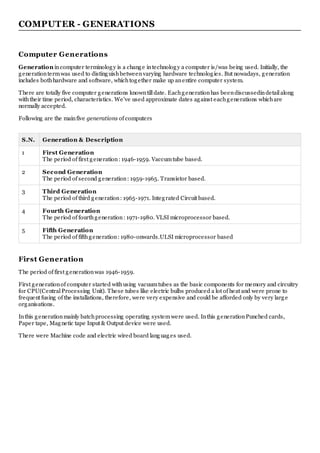
Computer Generations Overview
- 1. COMPUTER - GENERATIONS Computer Generations Generation incomputer terminology is a change intechnology a computer is/was being used. Initially, the generationtermwas used to distinguishbetweenvarying hardware technologies. But nowadays, generation includes bothhardware and software, whichtogether make up anentire computer system. There are totally five computer generations knowntilldate. Eachgenerationhas beendiscussedindetailalong withtheir time period, characteristics. We've used approximate dates against eachgenerations whichare normally accepted. Following are the mainfive generations of computers S.N. Generation & Description 1 First Generation The period of first generation: 1946-1959. Vaccumtube based. 2 Second Generation The period of second generation: 1959-1965. Transistor based. 3 Third Generation The period of third generation: 1965-1971. Integrated Circuit based. 4 Fourth Generation The period of fourthgeneration: 1971-1980. VLSI microprocessor based. 5 Fifth Generation The period of fifthgeneration: 1980-onwards.ULSI microprocessor based First Generation The period of first generationwas 1946-1959. First generationof computer started withusing vacuumtubes as the basic components for memory and circuitry for CPU(CentralProcessing Unit). These tubes like electric bulbs produced a lot of heat and were prone to frequent fusing of the installations, therefore, were very expensive and could be afforded only by very large organisations. Inthis generationmainly batchprocessing operating systemwere used. Inthis generationPunched cards, Paper tape, Magnetic tape Input & Output device were used. There were Machine code and electric wired board languages used.
- 2. The mainfeatures of First Generationare: Vacuumtube technology Unreliable Supported Machine language only Very costly Generate lot of heat Slow Input/Output device Huge size Need of A.C. Nonportable Consumed lot of electricity Some computer of this generationwere: ENIAC EDVAC UNIVAC IBM-701 IBM-650 Second Generation The period of second generationwas 1959-1965. This generationusing the transistor were cheaper, consumed less power, more compact insize, more reliable and faster thanthe first generationmachines made of vaccumtubes.Inthis generation, magnetic cores were
- 3. used as primary memory and magnetic tape and magnetic disks as secondary storage devices. Inthis generationassembly language and highlevelprogramming language like FORTRAN, COBOL were used. There were Batchprocessing and Multiprogramming Operating systemused. The mainfeatures of Second Generationare: Use of transistors Reliable as compared to First generationcomputers Smaller size as compared to First generationcomputers Generate less heat as compared to First generationcomputers Consumed less electricity as compared to First generationcomputers Faster thanfirst generationcomputers Stillvery costly A.C. needed Support machine and assmebly languages Some computer of this generationwere: IBM 1620 IBM 7094 CDC 1604 CDC 3600 UNIVAC 1108 Third Generation The period of third generationwas 1965-1971. The third generationof computer is marked by the use of Integrated Circuits (IC's) inplace of transistors.A
- 4. single I.C has many transistors, resistors and capacitors along withthe associated circuitry.The I.C was invented by Jack Kilby. This development made computers smaller insize, reliable and efficient. Inthis generationRemote processing, Time-sharing, Real-time, Multi-programming Operating Systemwere used. Highlevellanguage (FORTRAN-II TO IV, COBOL, PASCAL PL/1, BASIC, ALGOL-68 etc.) were used during this generation. The mainfeatures of Third Generationare: IC used More reliable Smaller size Generate less heat Faster Lesser maintenance Stillcostly A.C needed Consumed lesser electricity Support highlevellanguage Some computer of this generationwere: IBM-360 series Honeywell-6000 series PDP(PersonalData Processor) IBM-370/168 TDC-316 Fourth Generation The period of FourthGenerationwas 1971-1980.
- 5. The fourthgenerationof computers is marked by the use of Very Large Scale Integrated (VLSI) circuits.VLSI circuits having about 5000 transistors and other circuit elements and their associated circuits ona single chip made it possible to have microcomputers of fourthgeneration. FourthGenerationcomputers became more powerful, compact, reliable, and affordable. As a result, it gave rise to personalcomputer (PC) revolution. Inthis generationTime sharing, Realtime, Networks, Distributed Operating Systemwere used. Allthe Higher levellanguages like C and C++, DBASE etc. were used inthis generation. The mainfeatures of FourthGenerationare: VLSI technology used Very cheap Portable and reliable Use of PC's Very smallsize Pipeline processing No A.C. needed Concept of internet was introduced Great developments inthe fields of networks Computers became easily available Some computer of this generationwere: DEC 10 STAR 1000 PDP 11
- 6. CRAY-1(Super Computer) CRAY-X-MP(Super Computer) Fifth Generation The period of FifthGenerationis 1980-tilldate. Inthe fifthgeneration, the VLSI technology became ULSI (Ultra Large Scale Integration) technology, resulting inthe productionof microprocessor chips having tenmillionelectronic components. This generationis based onparallelprocessing hardware and AI (ArtificialIntelligence) software. AI is anemerging branchincomputer science, whichinterprets means and method of making computers think like humanbeings. Allthe Higher levellanguages like C and C++, Java, .Net etc. are used inthis generation. AI includes: Robotics Neuralnetworks Game Playing Development of expert systems to make decisions inreallife situations. Naturallanguage understanding and generation. The mainfeatures of FifthGenerationare: ULSI technology Development of true artificialintelligence Development of Naturallanguage processing Advancement inParallelProcessing Advancement inSuperconductor technology
- 7. More user friendly interfaces withmultimedia features Availability of very powerfuland compact computers at cheaper rates Some computer types of this generationare: Desktop Laptop NoteBook UltraBook ChromeBook
